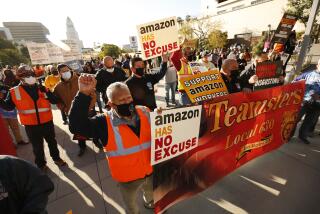Keeping It Simple
- Share via
In a Southwest Airlines educational video, pilots and flight attendants sing about employee benefits set to the music of Broadway show tunes.
Drivers for the J.B. Hunt trucking company in Lowell, Ark., pop a new Super Driver cassette into their tape decks each month with the latest benefit plan updates sandwiched between country music hits.
Solar Turbine employees in San Diego log on to a company computer system that spells out how their benefits will change if they get married, have a baby or experience other major life events.
Companies are trying whatever it takes to get the message across: Employee benefits are important. It pays to understand your options.
“Communications has become a very big movement in the employee benefit industry,” said Barry Lawrence, a spokesman for the Society for Human Resource Management, a professional organization based in Alexandria, Va. “You can have the greatest benefit plans in the world, but if no one can understand it, it’s not much of a benefit.”
The stakes for workers are high. Benefits are becoming increasingly valuable as companies add more choices of health, insurance and retirement savings plans. Employee benefits typically account for 30% to 40% of a worker’s total compensation.
But the additional choices have meant more confusion as human resource departments struggle to keep up with the changes and educate workers about new options and prices.
The experts advice? Keep it simple.
“The main thing is not to give them so much information that they will never read it,” said Rene Betsch, a Los Angeles-based communications consultant with the employee benefits firm Buck Consultants.
Then, she recommends, follow the old adage: Tell them what you’re going to be telling them; tell them; then tell them what you’ve just told them. Repeat as necessary.
“We’ll send them a notice that they’re going to be getting something in the mail and tell them when they’re getting it,” Betsch said. “After it’s been sent, we’ll send them a follow-up notice asking whether they received their materials. It’s hard for them to be oblivious to what’s going on.”
Employees may know something is going on but just figure they won’t be able to understand it. From top executives to factory workers, many people are intimidated by money issues. Throw in the baffling benefits-speak that fills most employee benefits literature and avoidance-tendency syndrome sets in.
Breaking through that resistance will take a steady stream of information distributed via multiple outlets, such as newsletters, interoffice mail, posters, faxes and payroll stuffers.
“Repetition is key,” said Libby Sartain, whose official title is vice president of people at Southwest Airlines’s Dallas headquarters. “You have to tell somebody something three times and in three different ways before it starts to sink in.”
Southwest distributes a mock newspaper to employees called Benefits Plus Today and arranges for visits with benefits specialists, in addition to its benefit video.
Employers should build their communication plan with their target audience in mind.
“People are so uncomfortable with financial material because they think they’re going to be intimidated,” said Deborah Milne, a director of the Employee Benefit Research Institute in Washington. “Target your audience and speak to them in a way they feel comfortable and identify with.”
At Nike, sports permeate every facet of the Beaverton, Ore., company, and spokeswoman Donna Gibbs says that employee benefits are no exception. Information on Nike’s benefits package isn’t written by the human resources department, but by the company’s hip image design group, which is responsible for formulating Nike’s public image.
“We make references to the world of sports, since that’s what defines us as a culture and as a brand,” she said of the company’s benefits materials. “We try to bring that into everything.”
Another approach is to structure benefits information around the life events of employees, rather than the traditional categories like health insurance or retirement plans.
This spring, Solar Turbines introduced a new benefits communication campaign that isn’t structured around artificial happenings like open enrollment periods. Employees receive a folder of color-coded one-page sheets with titles such as, “What if I Get Married?” “What if I Get Divorced?” and “What if I Have a Child?”
“It tells them what they need in life events situations,” said Sioban Kanine, a human resource principal at the company.
Now that Solar Turbine’s benefits information is organized in a user-friendly manner, the company has embarked on a three-year project to load it onto a company intranet that can be accessed by the firm’s 4,200 employees. An employee can dial into the system and click on a color-coded icon to access benefit information.
New technologies are making it easier for other workers to find out how their benefits plans will affect them. Toyota Motor Manufacturing USA Inc. in Georgetown, Ky., won a contest sponsored by the Employee Benefit Research Institute for developing an interactive computer program that helps workers calculate whether they are saving enough money for retirement.
The increasing complexity of many benefits plans is driving the use of technology to educate workers, said Curtiss Butler, director of Buck Consultants’ national new media practice.
“It used to be that everybody had one health insurance plan and one pension plan and they could take it or leave it,” he said. “Today we’re providing many, many more choices for employees. As you step back and look at that, you have to say, ‘Do these employees really understand what is being asked of them? And if not, what kinds of tools can we develop to help them understand the differences among these options?’ ”
He is working with a major New England-based consumer goods manufacturer to implement a computer system that allows employees to check on their benefits package through a touch-screen kiosk. Its debut is scheduled for early next year.
Building such a network is not cheap. And even low-tech benefits communications campaigns can be expensive. But after spending hundreds of thousands of dollars to provide the employee benefits, companies are loathe to see their money go to waste.
“It’s a tremendous financial investment to have these plans available, and some employees are not even aware of what these benefits are worth,” Betsch said. “The company wants to make sure they’re not taking it for granted and are getting the most bang for the buck.”
More to Read
Inside the business of entertainment
The Wide Shot brings you news, analysis and insights on everything from streaming wars to production — and what it all means for the future.
You may occasionally receive promotional content from the Los Angeles Times.











